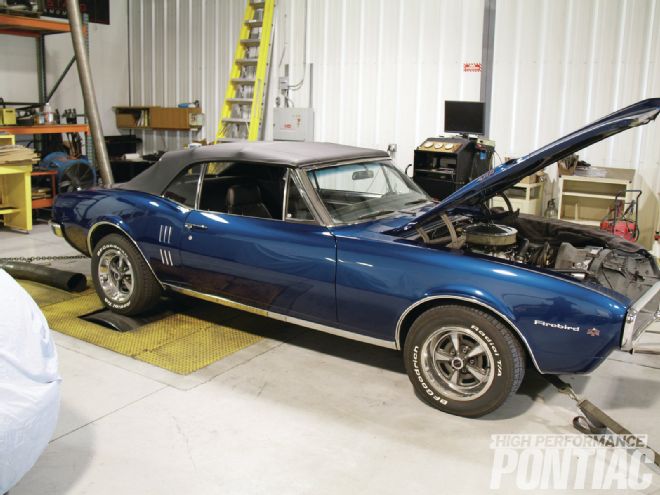
Inlast month's issue, we outlined the installation of an electronic fuel injection (EFI) system onto the vintage Pontiac V-8 residing in Lou Rotella's 1967 Firebird. Its modified Quadrajet carburetor performed suitably at all speeds, but if the car sat for several days, the fuel in the Q-jet's float bowl usually evaporated, which required excessive cranking to get it started. And even with a fully functional electric choke, the 455 was very cold-blooded and required extended warm-up time before hitting the streets, especially in cooler weather.
While those characteristics may be considered the romance of driving a vintage vehicle with a carbureted engine, it certainly leaves much to be desired when compared to modern fuel-injection systems ... so much so in fact that we were asked to find a complete EFI system for the Firebird's 455 that would provide excellent drivability and performance at all speeds and conditions. That's where Fuel Air Spark Technology (FAST) and its EZ-EFI system come in.
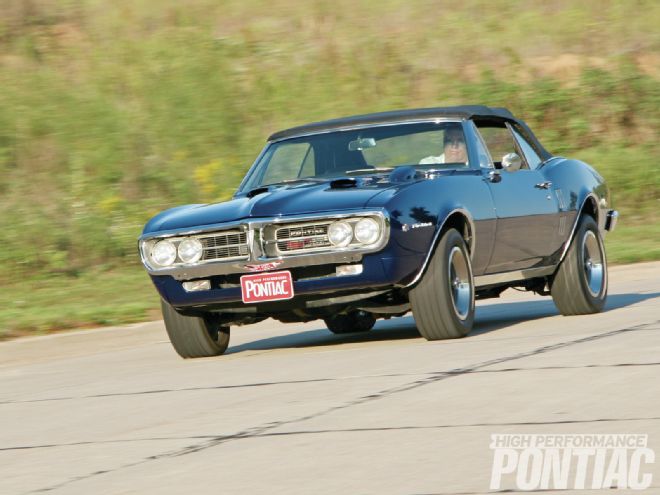
Generally considered among the most user-friendly EFI systems available, EZ-EFI No. 30227-KIT retails for $2,200 and includes all of the required fuel system and electrical components for a proper install, as well as a self-contained throttle body fitted with four fuel injectors. Best of all, it requires only minimal operator input for initial startup and "learns" what the engine wants to perform optimally in all conditions and ranges as you drive it. So how does the EZ-EFI system compare to a modified Quadrajet? Follow along as we detail the initial startup process, fine tune the system programming, and hit the chassis dyno for a power measurement.
Install Overview
The Firebird's 455 is mildly modified and uses mostly stock components. Now displacing 462 ci, its 4X heads flow approximately 230 cfm and produce a compression ratio of 9.7:1, and a 232/243 hydraulic flat-tappet camshaft actuates the valves. It inhales through an Edelbrock Performer RPM intake manifold and exhales through a set of Dynomax tubular headers and a transverse-mounted Flowmaster muffler. Though a relatively simple combination, it's always performed respectably, generating plenty of torque for tire smoking fun—while the lack of traction prevents it from twisting the convertible body into a knot.
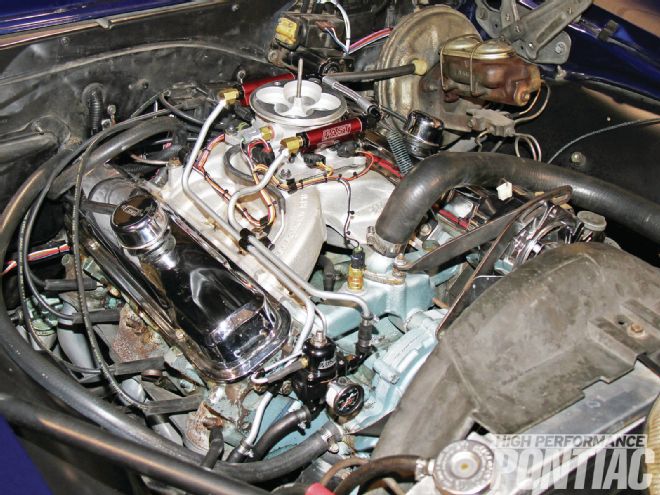 1. In last month’s issue of HPP we outlined the process of installing an EZ-EFI fuel injection system onto a vintage Pontiac V-8. T&M Automotive in Omaha, Nebraska, performed the task, giving the entire system a factory-installed look. Does it perform as well as it looks? Read on to find out!
1. In last month’s issue of HPP we outlined the process of installing an EZ-EFI fuel injection system onto a vintage Pontiac V-8. T&M Automotive in Omaha, Nebraska, performed the task, giving the entire system a factory-installed look. Does it perform as well as it looks? Read on to find out!
Because of time and space constraints, we enlisted T&M Automotive in Omaha, Nebraska, for the EZ-EFI install. Detailed in the previous issue, installation was straightforward without any unexpected problems. A feature FAST boasts about is its EZ-EFI systems Engine Control Unit (ECU) setup for initial engine startup and an adaptive learning mode where the ECU continually adjusts as you drive to achieve optimal performance in all conditions for the particular engine. In other words, once you set the basic parameters, you'll only need to adjust a couple of variables to get your Pontiac running its best. So let's get to it.
Initial Startup and Tuning
After performing the required steps outlined by the handheld unit's Setup Wizard, we started the 455 for the first time. As expected, it idled rough and stumbled regularly for the first few minutes. Once the coolant temperature reached 140 degrees F, the ECU switched to adaptive *learning mode. It began to improve our 455's idle quality, but we found unless it was completely up to normal operating temperature, it often died when the Turbo 400 was placed into gear. After experiencing the same symptoms a few more times, we began wondering just what we'd gotten ourselves into!
After mustering the courage to drive it on the street, we found the EZ-EFI system very smooth and responsive at constant speeds, but any abrupt movement of the accelerator caused the engine to stumble and/or die. Drivability and performance was clearly improving as miles accumulated. After about 30 miles of driving in all types of conditions, we parked it for the night and called FAST's technical department to explain our concerns and seek guidance on adjusting the Idle Air Control (IAC) valve to improve cold startup as outlined in the instructions.
FAST Technical Consultant Kevin Winstead took our call and assured us that everything we'd seen up to that point was normal and that we should expect to see further improvements the more we drove it. We explained the cold startup symptoms and he suggested that we first verify the IAC count at hot idle using the Live Data feature on the handheld.
With the throttle blades at a fixed angle, the IAC valve contains an internal solenoid that continually opens and closes to provide the engine with a precise amount of bypass air to produce a stable idle. By adjusting the throttle-blade set screw, we could change the closed angle to allow more or less airflow past, which alters how many times the IAC valve cycles. That cycle is referred to as an IAC count. Reducing the IAC count lessens the number of times is IAC opens, which makes it more effective overall, but particularly when the engine is cold.
After another cold-startup sequence the next day, we found the engine operated better on its own, but was far from our expectations of how a fuel-injected engine should idle. Per Winstead's recommendation, we allowed the engine to reach its normal operating temperature and found the IAC count at hot idle was more than 60, and the instructions recommended about 20. We called Winstead to discuss our finding and he instructed us to adjust the throttle blades until the IAC count drops between 10 and 20, and then recalibrate the Throttle Position Sensor (TPS).
Heeding his advice, we performed the appropriate steps. The next morning we twisted the key and were rewarded with immediate and consistent cold startup. The engine immediately went to high idle (1,000-plus rpm) for several seconds and settled into to our selected idle speed of 850 rpm. The idle was so stable that it was unaffected by gear selection and steering-wheel inputs.
Once up to temperature and on the road, the throttle response was simply amazing. Stepping into the accelerator produced immediate response that propelled the Firebird forward forcefully. Now this is what EFI is all about!
The Power Numbers
We spent hours tinkering with a 800-cfm Quadrajet to get it performing flawlessly at every point under normal driving conditions, and that included several pulls on the chassis dyno to be sure it was dialed in for maximum full-throttle performance. Just before the EFI install, we recorded the 455's output so we might establish a baseline to compare the performance effects EFI might have. After strapping it to the roller drum on the Mustang dyno at H.S. Automotive in Omaha, Nebraska, the 455 recorded a best of 282 hp at 4,800 rpm and 336 lb-ft at 4,100 rpm at the rear tires.
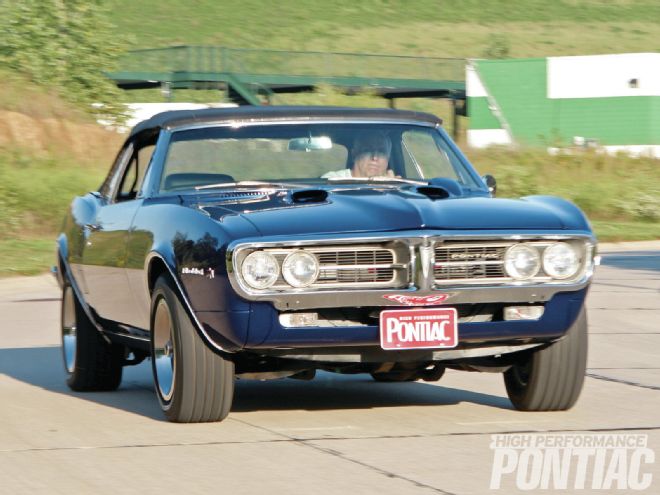 13. We found that the 455 idled rough during the first few cold startups, but it continued to improve slightly after each cycle. When coolant temperature is below 140 degrees F, the ECU deviates up to 25 percent for a strong idle. Once the coolant temperature reaches 140 degrees F, the system switches to AL mode, operating on what it learned the engine performs best with. We found drivability and performance improve with every mile. After several days of regular driving and minor adjustments, the 455 starts perfectly when cold and operates flawless at every point as it warms to its normal operating temperature.
13. We found that the 455 idled rough during the first few cold startups, but it continued to improve slightly after each cycle. When coolant temperature is below 140 degrees F, the ECU deviates up to 25 percent for a strong idle. Once the coolant temperature reaches 140 degrees F, the system switches to AL mode, operating on what it learned the engine performs best with. We found drivability and performance improve with every mile. After several days of regular driving and minor adjustments, the 455 starts perfectly when cold and operates flawless at every point as it warms to its normal operating temperature.
We returned to H.S. Automotive a few weeks later for a follow up dyno session after the EZ-EFI install. We must first preface that a TBI system works much like a carburetor. It still uses traditional throttle blades for air entry, but uses fuel injectors instead of boosters to atomize fuel. Where carburetor jet changes take several minutes and tailoring the air/fuel ratio for a particular engine throughout the entire pull can be tedious, an electronic EFI system can generally be adjusted with a few keystrokes or button pushes, and it can immediately compensate for air temperature and conditions, as well as altitude for maximum possible performance in any condition or location.
The main benefit to an EFI system is its ability to atomize fuel in all conditions and improve driveability in all ranges. We were completely satisfied with what we'd seen from the EZ-EFI system so far and simply hoped to achieve similar peak power numbers from the EZ-EFI. We understood anything more might suggest an issue with the functionality of the Quadrajet we replaced, but anything less may be something we'd have to live with since our intent was improved drivability, and it delivered exactly that.
With the Firebird strapped down, the first pull sounded crisp and clean, but when it commenced, we found the 455 now producing 266 rwhp and 304 rwtq—a loss of about 20 hp and 30 lb-ft. A bit disappointed, dyno operator T.J. Mrsny assured us that the FAST system likely requires a few full throttle pulls for the ECU to adjust accordingly. He suggested a few subsequent pulls and just as he predicted, we saw the numbers climb each time. By the fourth pull we were at 284 rwhp and 337 rwtq—nearly identical to what we saw from the Quadrajet. A few more pulls were made adjusting fuel and timing, but nothing topped the numbers generated with FAST's programmed targets.
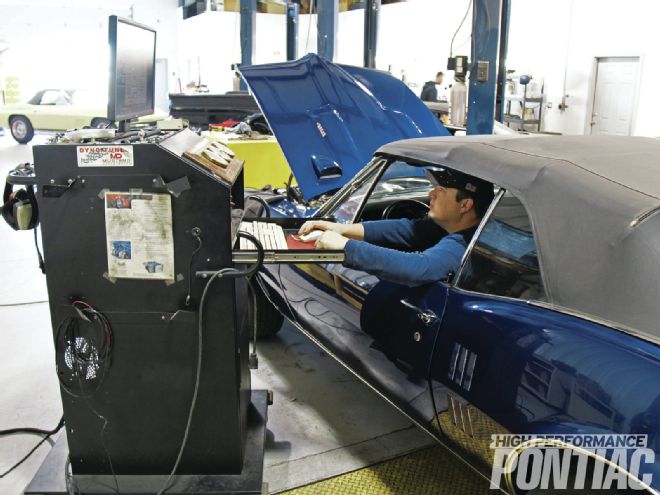 22. With changes limited to the EFI install only, our back-to-back dyno testing reveals that power numbers at the tires are practically identical. The pulls began at 2,900 rpm, which was just above the torque converter stall speed. It took many hours of trial and error testing with the Quadrajet to achieve what the EZ-EFI system did after just four full-throttle pulls. It’s simply that good!
22. With changes limited to the EFI install only, our back-to-back dyno testing reveals that power numbers at the tires are practically identical. The pulls began at 2,900 rpm, which was just above the torque converter stall speed. It took many hours of trial and error testing with the Quadrajet to achieve what the EZ-EFI system did after just four full-throttle pulls. It’s simply that good!
Conclusion
The addition of an EZ-EFI fuel injection system has transformed the usability of this particular Firebird. Where it was once difficult to start and drive cold, it now starts immediately and can be driven away within seconds of startup (though we do recommend a minute or two of idle time to allow the fluids to circulate and warm up in cold temps). With as sensitive as the throttle response is, we're certain fuel economy will increase, but we simply couldn't resist stabbing the accelerator to feel the immediate responsiveness the EFI system offers. Best of all, we were able to achieve power numbers nearly identical to the carburetor with minimal tuning effort, and we greatly improved the street manners and overall driveability. That's exactly what the owner was after.
Vehicle Specifications
Year/Model: 1967 Firebird 400 convertible
Weight With Driver: Approx 3,750 lb
Fuel: 91-octane
Engine: 1970 code-YH 455
Cubic Inches Before/After: 455/462
Engine Built By: Willard Auto Machine
Induction System
Air Cleaner: Open element, 14x2-inch diameter
Fuel Injection: . FAST EZ-EFI throttle body, 1,000+ cfm
Intake Manifold: Performer RPM
Fuel System
Pump: FAST electric fuel pump, 240 lph
Heads
Casting: 1974 No. 4X-7H
Head Porting: Mild home porting
Peak Airflow Numbers at 28-inches: 230 cfm
Bottom End
Pistons: TRW forged-aluminum No. L2359F
Rings: Sealed Power replacement
Rods: Stock cast with ARP fasteners
Compression Ratio: Approximately 9.7:1
Crankshaft: Original nodular-iron, 4.21-inch stroke
Rotating Assembly Balanced: Yes
Camshaft
Brand: Nunzi's Automotive hydraulic flat tappet
Duration at 0.050: 232/243-deg
Duration Advertised: 301/313-deg
Lift with Specified Rocker Arms: 0.460/0.470-in
Lobe Separation Angle: 113-deg
Intake Centerline: 109-deg
Rocker Arms: Crower cast-alloy roller, 1.6:1 Ratio
Ignition
Distributor: Pontiac HEI
Coil: Stock ACDelco
Wires: Taylor 8mm
Spark Plugs: ACDelco No. R45S
Total Timing: 36-deg
RPM Total Timing Is Reached: 3,200
Exhaust
Headers: Dynomax four-tube 1.75-inch primary tubes, 2.5-inch collectors
Exhaust Pipes: 2.25-inch
Muffler: Flowmaster crossflow, No. 42582
Crossover: None
Drivetrain
Transmission: Turbo-400
Converter: Continental, 2,600 stall
Rear Axle: Original 8.2-in GM 10-bolt
Rear Gear Ratio: 3.55:1